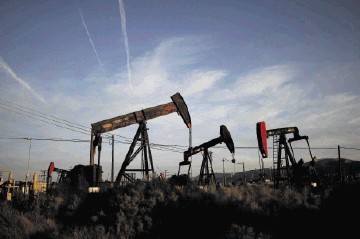
US oil drillers are finally beginning to buckle.
For more than a year, American oil producers found a way to keep pumping despite a worldwide slide in crude prices.
Like cartoon character Wile E. Coyote, US drillers dashed off the cliff and somehow kept running in midair, maintaining volumes even as revenue plummeted.
Drilling companies’ latest projections, released in earnings reports in recent days, suggest gravity is finally taking hold.
Apache Corp expects oil and natural gas production to fall as much as 11 percent in 2016, the company said Thursday, a day after Continental Resources Inc. projected a 10 percent cut and Whiting Petroleum Corp., a 15 percent reduction. Devon Energy Corp. forecast a 10 percent decline earlier in the month.
With crude prices near a 12-year low, drillers are deciding it’s best to keep their barrels in the ground, heeding the advice this week of Saudi Arabia’s Ali al-Naimi. In comments at the IHS CERAWeek energy conference in Houston, Naimi told U.S. producers their only choices were to “lower costs, borrow cash or liquidate” to survive the downturn.
West Texas Intermediate, the U.S. benchmark crude, rose 2.9 percent to settle at $33.07 Thursday.
“This is the fork in the road,” Subash Chandra, a Guggenheim Securities analyst in New York, said in a telephone interview. “We know which direction we’re going — we’re going down — in terms of volumes. The only question is at what velocity we’re going down that path.”
The surprising resilience of U.S. producers has been a key factor in the 70 percent slide in crude prices over the past 20 months, with operators cutting costs and squeezing more petroleum out of fewer wells to stave off the reckoning. Saudi Arabia, the biggest producer in the Organization of Petroleum Exporting Countries, has ruled out a cut in the nation’s output, according to Naimi, leaving U.S. shale to carry the burden of balancing the market.
While sales of new shares and income from hedging contracts that temporarily locked in higher prices helped keep the shale industry afloat in 2015, the piper is calling, Scott Sheffield, chief executive officer at Pioneer Natural Resources Co., told the conference. The industry is in “hunker down, hunker down,” mode, he said.
Output from the Eagle Ford shale region in Texas is likely to fall 1 million barrels a day, Sheffield said. That’s a 9 percent decline from the 1.1 million a day produced in 2015, according to Railroad Commission of Texas data.
Pioneer is one of the few outliers, forecasting its volumes will grow by 10 percent this year. Others are pulling back and slashing capital spending budgets in an attempt to hoard cash and ensure they can meet debt payments.
“We’ve decided to slow down and preserve our cash on hand,” Cimarex Energy Co.’s Tom Jorden told analysts on a Feb. 17 conference call. “Production growth will have to take a backseat to flexibility and balance sheet preservation.” Cimarex has forecast a decline of more than 5 percent in 2016 output.
Anadarko Petroleum Corp. expects its production to fall as much as 4 percent. With oil priced at $30 a barrel, “we’re just not getting the returns that we would want to get,” Executive Vice-President Robert Daniels told a Credit Suisse conference Wednesday.
All that’s still not enough to dispel an oil glut expected to last well into 2017, said Guggenheim’s Chandra. Other U.S. producers have said they plan to hold volumes steady and many “are hoping the weaker hands in the industry can absorb all the declines,” he said.
“The changes that have to occur industrywide to deal with what we see coming are going to be dramatic,” he said.
Recommended for you
